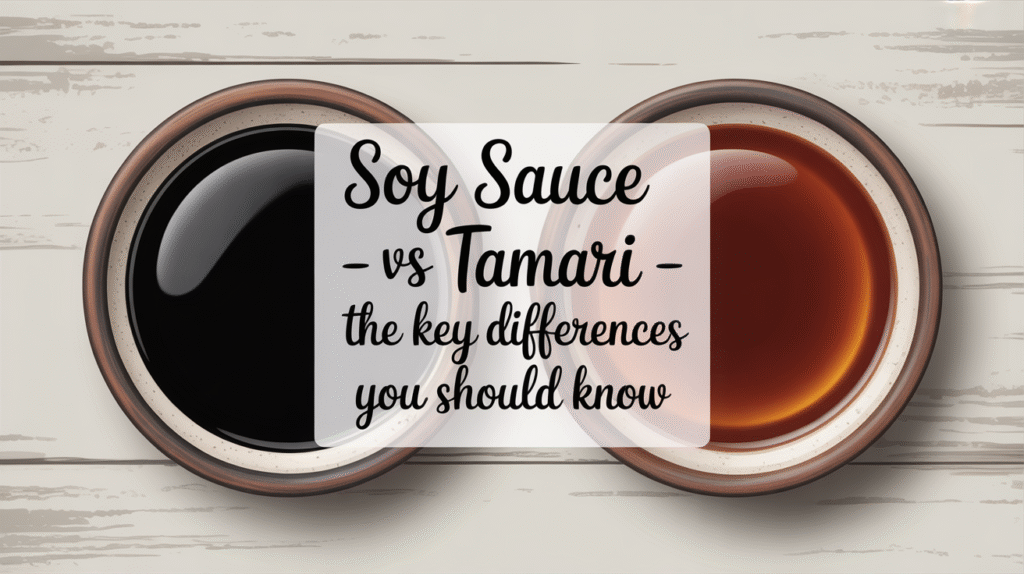Affiliate Disclosure: PantryBrands.co.uk is a participant in the Amazon.co.uk Associates Programme. As an Amazon Associate, we earn from qualifying purchases made through links on this site.
The main difference between soy sauce and tamari is that tamari is typically gluten-free and has a smoother, less salty taste, while soy sauce often contains wheat and has a sharper flavour. Though they may look similar, the two sauces differ in ingredients, flavour profile, brewing process, and dietary suitability.

In this article, we’ll explore the core differences between soy sauce and tamari, helping you choose the right one based on taste, cooking use, and dietary needs.
What Is Soy Sauce?
Soy sauce is a dark, salty liquid seasoning made from fermented soybeans, roasted wheat, water, and salt. It originated in China and has since spread to become a staple in Japanese, Korean, and Western cuisines.
Characteristics of Soy Sauce
Soy sauce varies by region, but typically includes:
- A strong umami taste with a salty finish.
- A thinner consistency and lighter colour compared to tamari.
- Multiple varieties: light, dark, reduced-salt, and sweet soy.
It’s commonly used for stir-fries, marinades, dipping sauces, and broths.
What Is Tamari?
Tamari is a Japanese soy-based sauce that is usually made without wheat, making it naturally gluten-free in most cases. It’s a by-product of miso paste fermentation, giving it a richer and less sharp taste.
Characteristics of Tamari
Tamari stands out for its flavour and dietary compatibility:
- Typically wheat-free and gluten-free (check the label to be sure).
- A thicker consistency with a more mellow, less salty taste.
- Ideal for those with coeliac disease or gluten sensitivity.
Ingredient Differences Between Soy Sauce and Tamari
The ingredients in each sauce impact both flavour and suitability for specific diets.
Soy Sauce Ingredients
Standard soy sauce contains:
- Soybeans
- Roasted wheat
- Water
- Salt
- Sometimes preservatives or sweeteners (depending on brand)
This makes it unsuitable for gluten-free diets, unless specifically labelled gluten-free.
Tamari Ingredients
Traditional tamari contains:
- Soybeans
- Salt
- Water
- Fermentation agents
In most cases, tamari is brewed without wheat, making it ideal for gluten-free users, though not all tamari is guaranteed gluten-free unless certified.
Flavour Profile Comparison
Each sauce contributes a unique taste to dishes.
Soy Sauce Taste
Soy sauce has a sharper, saltier bite.
- Works well in bold-flavoured dishes.
- Enhances savoury components quickly.
Tamari Taste
Tamari is smoother and less aggressive in saltiness.
- Offers deeper umami without as much salt burn.
- Better for dipping or dishes where you want subtlety.
Cooking Uses: When to Choose Which
Though interchangeable in many recipes, certain cooking scenarios favour one sauce over the other.
Use Soy Sauce When:
Soy sauce works well in bold, salty dishes.
- Stir-frying vegetables, tofu, or meat.
- Creating marinades for a punch of flavour.
- Adding colour to fried rice or noodles.
Use Tamari When:
Tamari is excellent for more delicate or gluten-free cooking.
- Making gluten-free dressings, sauces, or soups.
- Dipping sushi or sashimi (smoother taste).
- Cooking with subtle or clean flavours where salt needs balance.
Gluten-Free Diet Considerations
For those with gluten intolerance or coeliac disease, soy sauce is not always safe.
Gluten-Free Soy Sauce Options
Some brands offer gluten-free soy sauce alternatives.
- Kikkoman and other major brands now sell certified gluten-free soy sauce.
- These are brewed without wheat but taste close to traditional soy sauce.
Tamari for Gluten-Free Cooking
Tamari is often the preferred gluten-free option.
- Naturally made without wheat (in most brands).
- Safer for sensitive diets and often labelled “gluten-free”.
Nutritional Differences
While both sauces are low in calories and fat, sodium levels can vary.
Sodium Content
Tamari and soy sauce both contain high levels of sodium.
- Regular soy sauce: around 900–1000 mg per tablespoon.
- Tamari: typically similar but may taste less salty due to its smoother flavour.
Low-sodium versions of both are available and better suited for heart-conscious diets.
Availability in the UK
Both sauces are easy to find, but some brands specialise in one or the other.
- Soy sauce: Widely available in supermarkets under brands like Kikkoman, Blue Dragon, Amoy.
- Tamari: Available in health food stores (Clearspring, San-J) and gluten-free aisles in major supermarkets.
FAQs About Soy Sauce vs Tamari
Here are some questions and answers about the differences between soy sauce and tamari.
Is tamari always gluten-free?
No, not all tamari is gluten-free. While most tamari is brewed without wheat, only those marked “gluten-free” on the label are safe for coeliacs or people with gluten intolerance.
Can I substitute tamari for soy sauce?
Yes, tamari can replace soy sauce in most recipes. Keep in mind that tamari is less salty and slightly thicker, so you may need to adjust quantity or seasoning.
Which is healthier: soy sauce or tamari?
Neither sauce is particularly “healthy”, as both are high in sodium. However, tamari often contains fewer additives and is better for those avoiding gluten or seeking a cleaner label.
Does tamari taste better than soy sauce?
That depends on personal preference. Tamari is smoother and more balanced, while soy sauce is sharper and saltier. Tamari is often preferred for dipping or light dressings.
Is tamari suitable for vegans?
Yes, tamari is suitable for vegans as it is made from soybeans, water, and salt, without any animal-derived ingredients.
